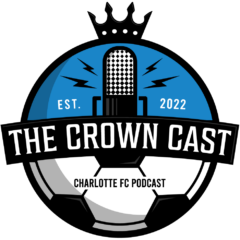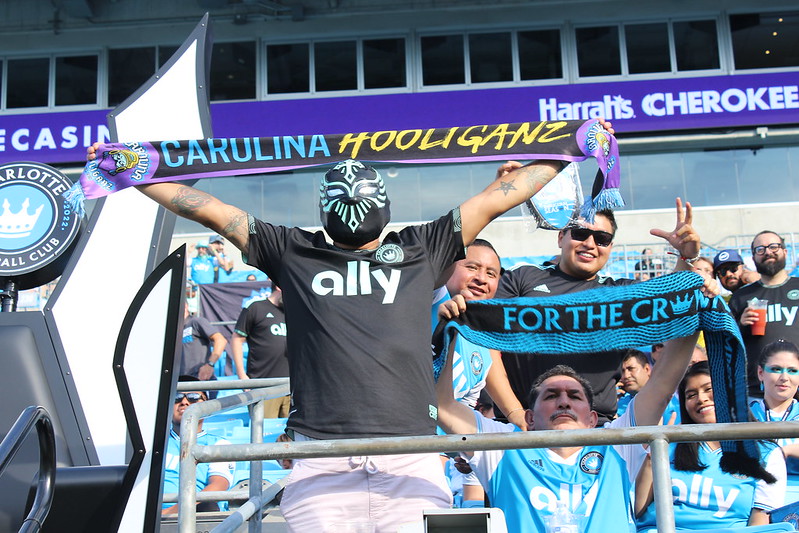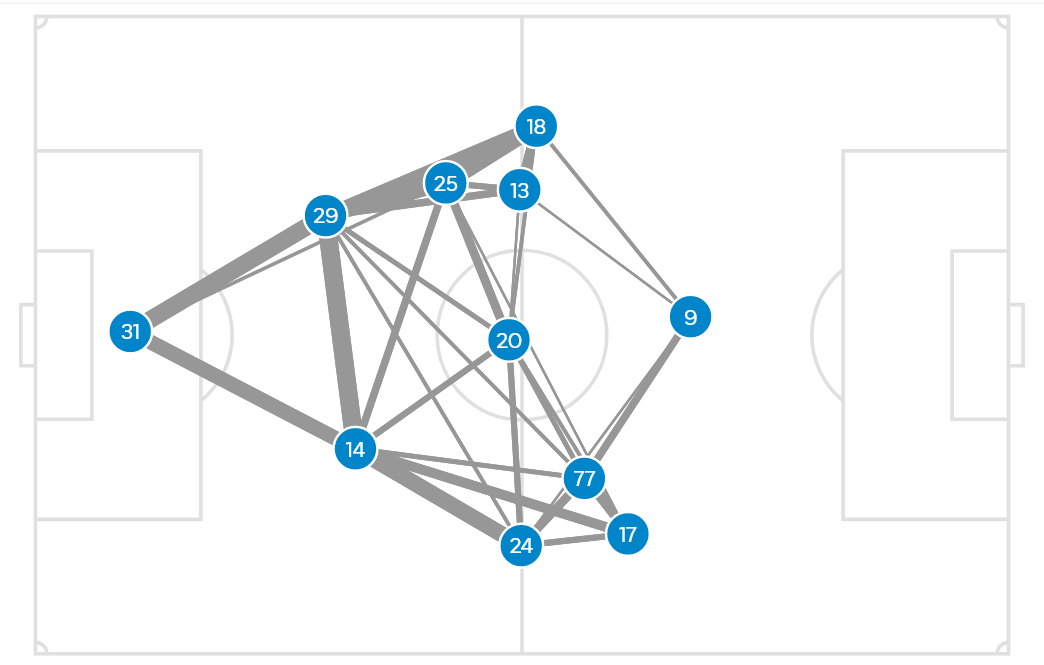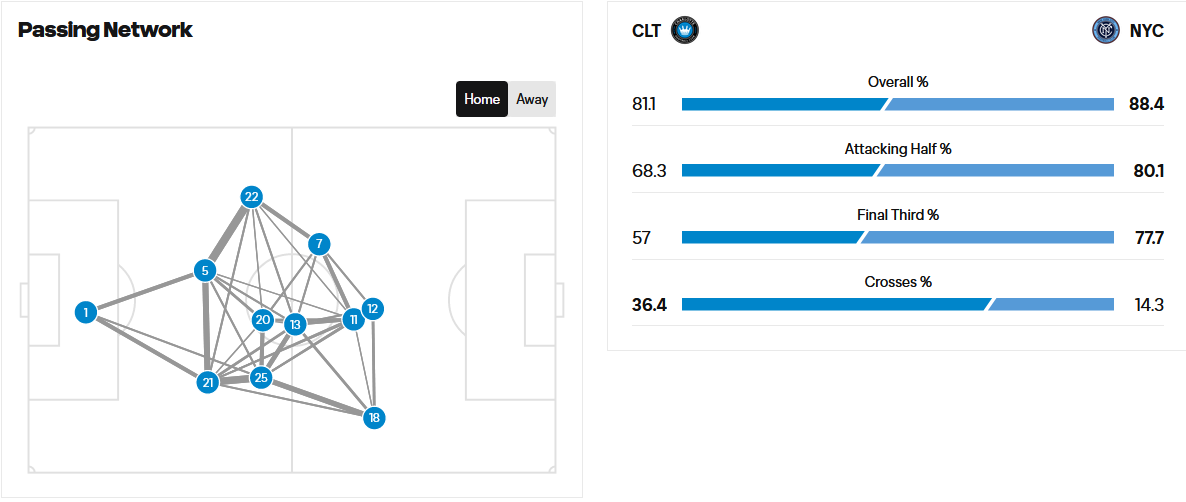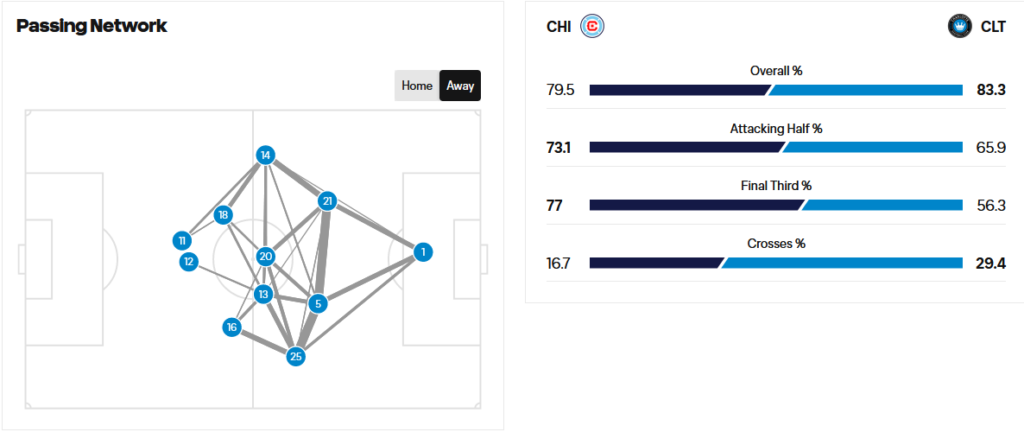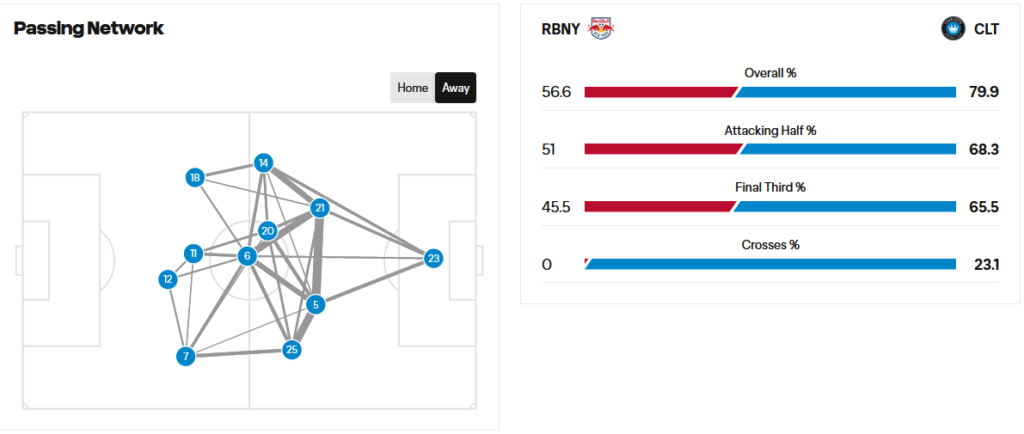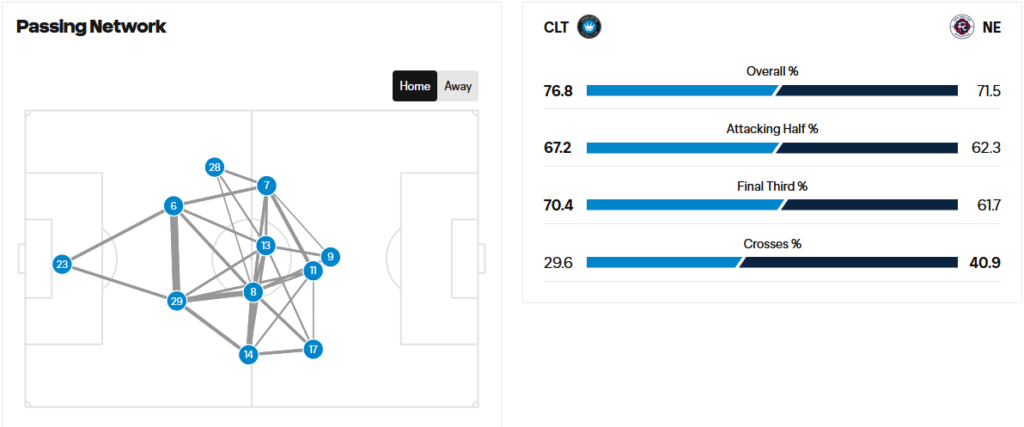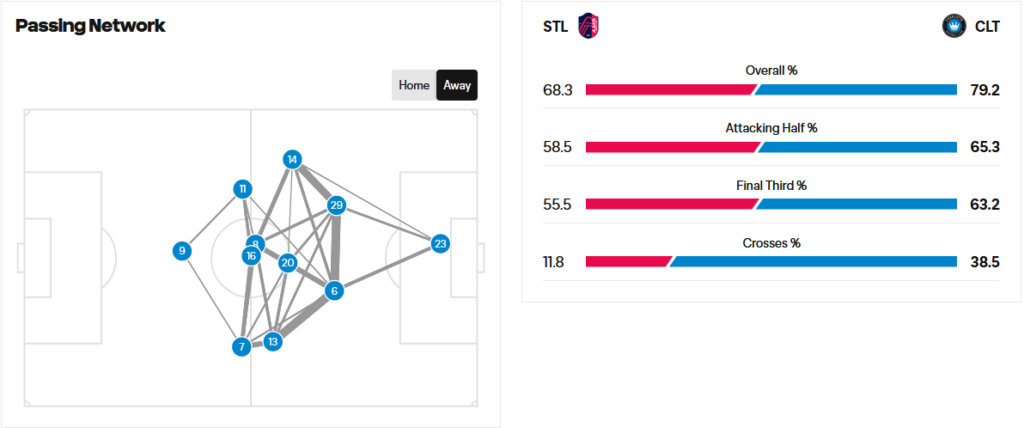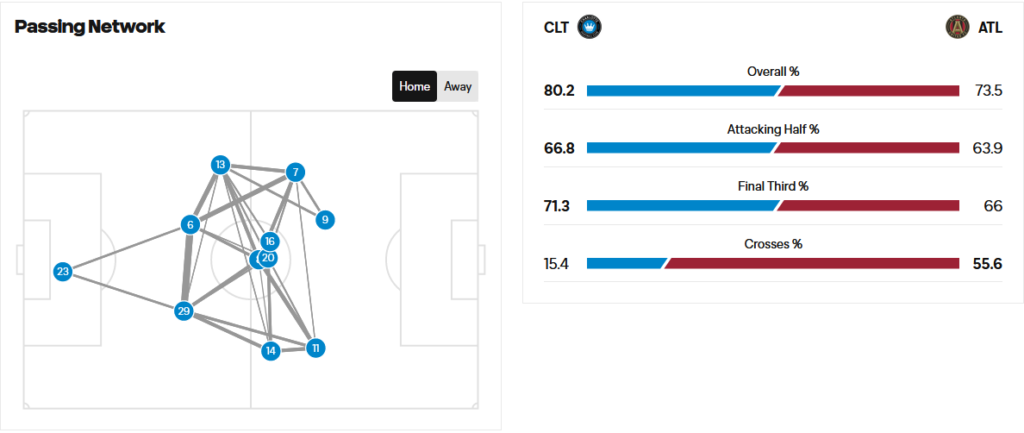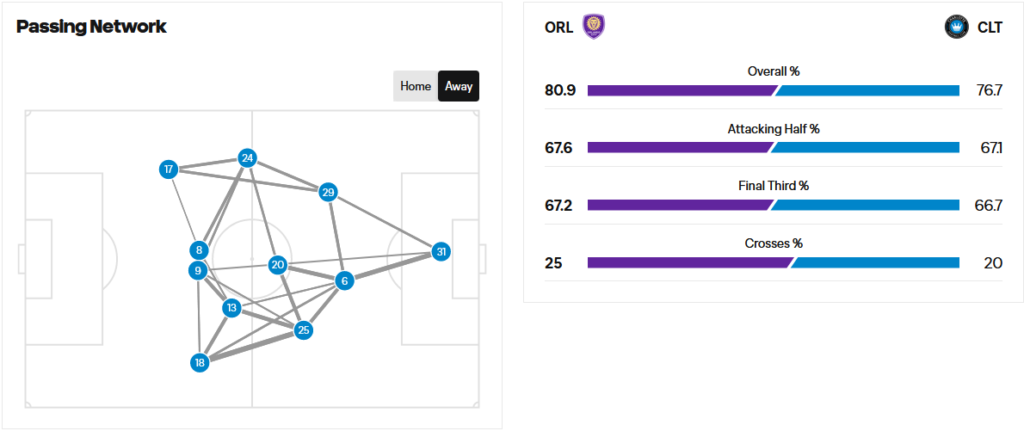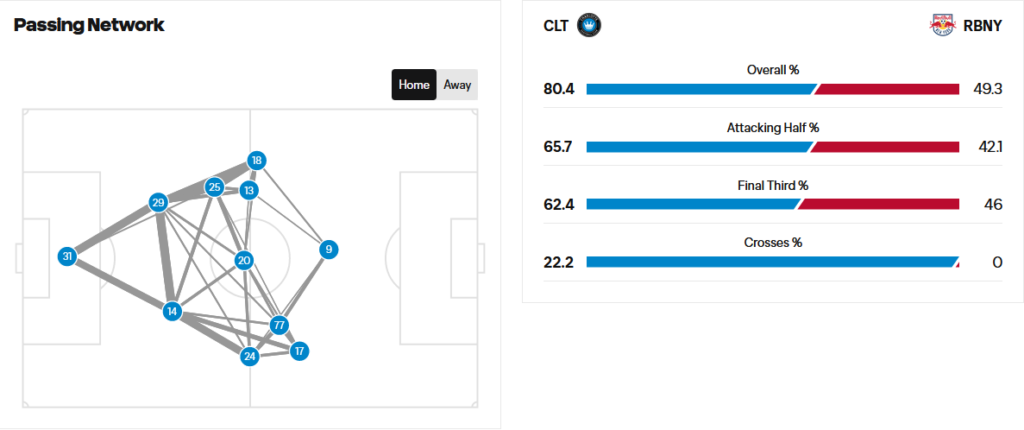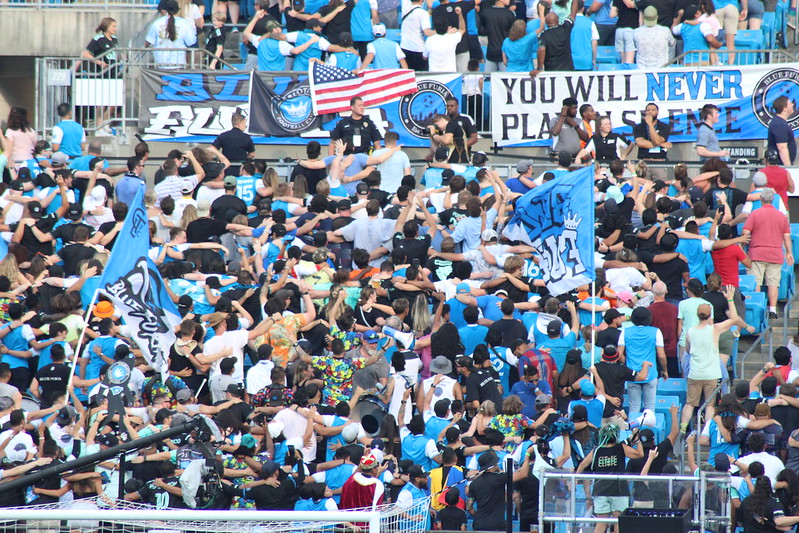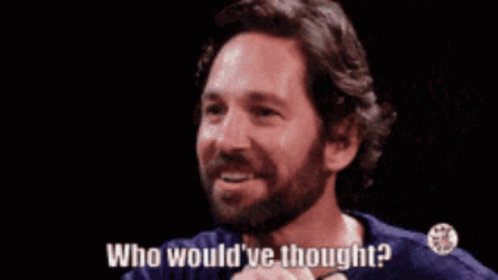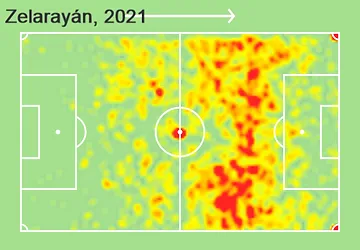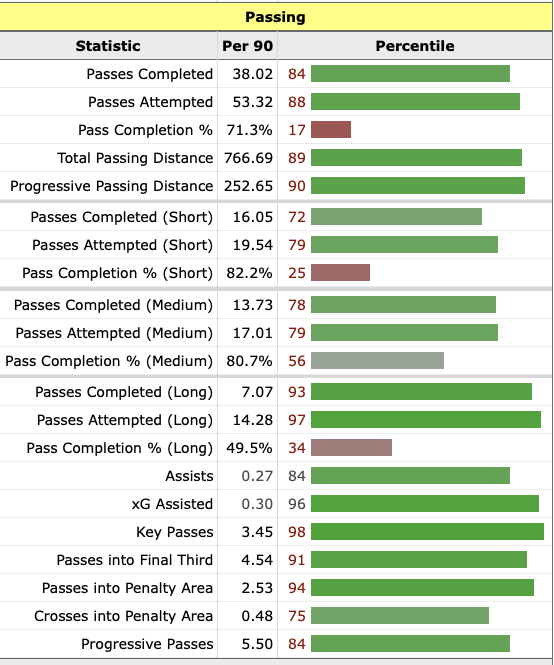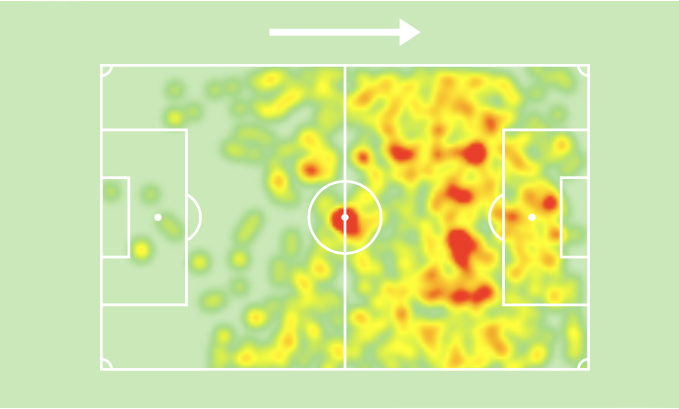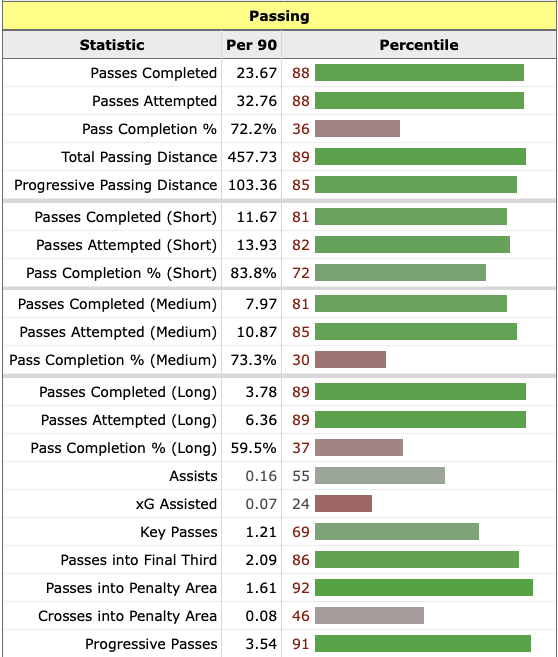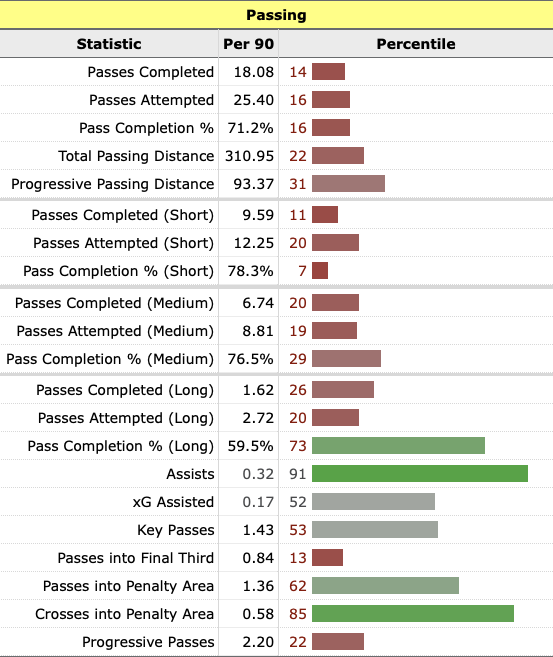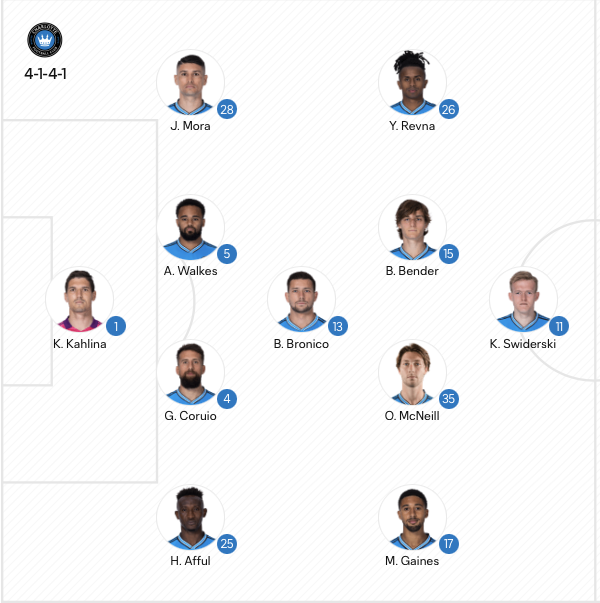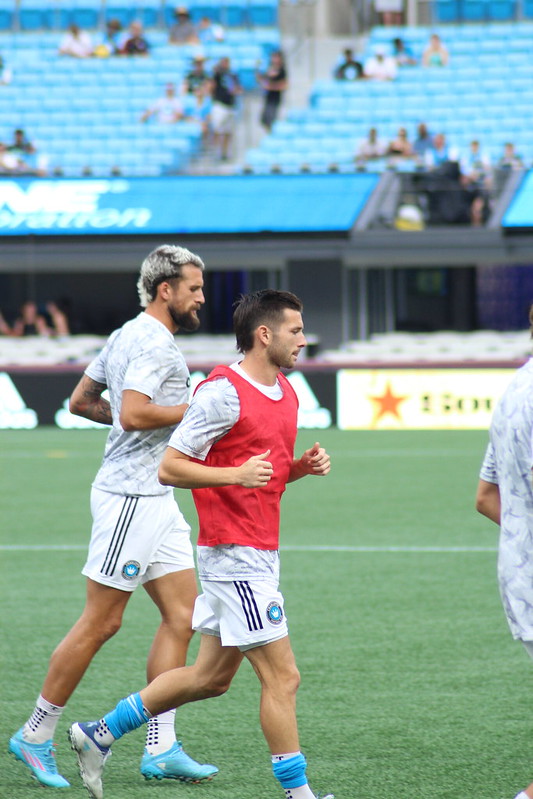It’s a big April ahead. I alluded to this yesterday in my post about our passing networks, but April provides a chance for Charlotte to earn a lot of points and erase the bad start to this season. A full 15 points from the 5 games is unrealistic, but something between 8-11 points would be really helpful to the cause.
With Karol having a pretty successful international break, I’m hoping that he comes back ready to go on a scoring run. That goal epitomized the player: good positioning and bad first touch, but ultimately a good finish.
Westwood’s injury is still something that continues to cloud our midfield selection. Now, Bronico will be serving a one game suspension for this challenge in the game against RBNY last weekend.
We can’t really have too many complaints as fans. In reality, we’re lucky we’ll only miss him for 1 game, as this easily could’ve been a red over the weekend plus a 3 match ban.
While I’m a huge fan of Brandt, I would like to see a midfield of Derrick Jones, Karol, and Westy. It’s something we haven’t seen yet. This would’ve been the perfect weekend to do so, but considering that I still haven’t seen word on his status, it seems unlikely to happen.
Lineups
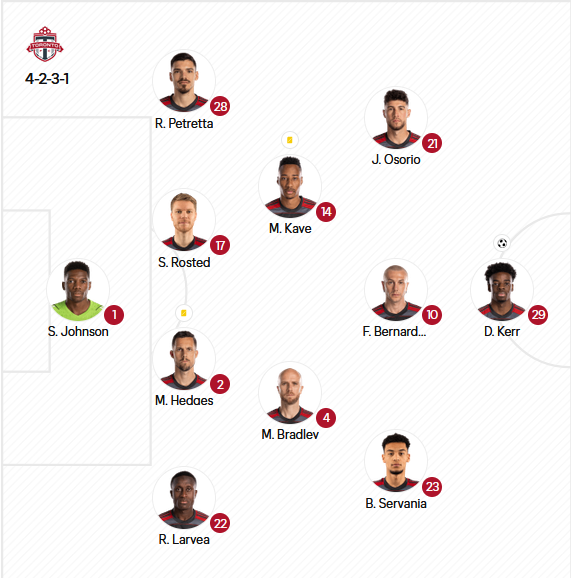
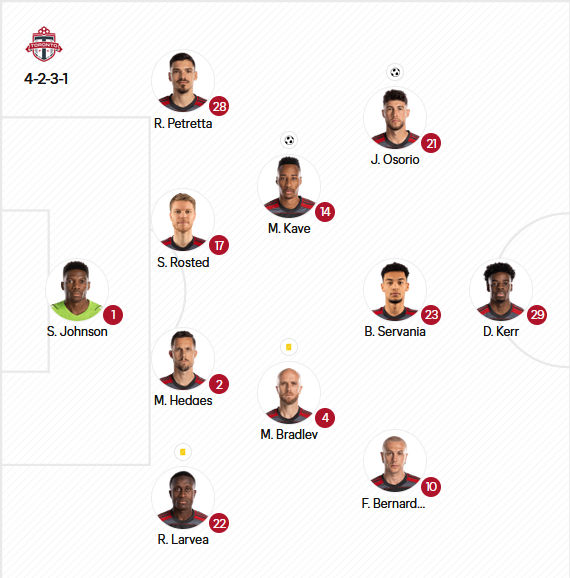
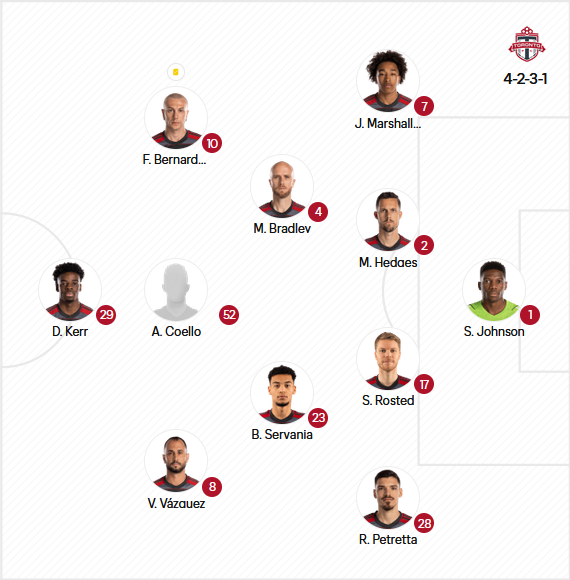
Unlike Charlotte, Toronto has been pretty consistent in its lineup and personnel. They’ve run a 4-2-3-1 over the past 3 games, and most of their personnel have remained the same. They are missing Lorenzo Insigne, who is one of the more talent players to ever come to MLS, but retain the services of his compatriot, Fernando Bernardeschi. Their backline and midfield has remained largely unchanged game to game. The biggest changes have been the result of injury and international duty.
Injury
Last week Toronto dealt with a myriad of injuries and unavailability due to the international break. According to the MLS Availability Report, the following players were unavailable for them:
- Cristian Gutierrez (OUT, illness)
- Adama Diomande (OUT, lower body)
- Lorenzo Insigne (OUT, lower body)
- Ayo Akinola (OUT, international duty)
- Mark-Anthony Kaye (OUT, international duty)
- Richie Laryea (OUT, international duty)
- Jonathan Osorio (OUT, international duty)
- Tomas Romero (OUT, international duty)
Some of these players have not featured at all or haven’t featured extensively for Toronto on the year (e.g., Romero, Akinola), but others were huge misses (e.g., Kaye, Osorio, Laryea). Lucky for Charlotte, those players should be back for our game!
Where Charlotte does have luck is in the absence of Lorenzo Insigne. He’s only played 33 minutes on the year and reinjured himself on March 14. As a result, he’s set to miss our game. Toronto still has plenty of attacking talent, but Insigne is a true game-changer. Having to play Toronto without him is a blessing.
Attack
Without Insigne, Toronto’s attack will be centered on Bernardeschi. The Italian had a much better debut than I was expecting. He always had talent, but after an 11-goal (3 PKs), 4-assist season in 2016-17 with Fiorentina which got him a move to Juventus, his production stagnated. Over 5 seasons and 134 appearances for Juve, he only managed 8 goals and 12 assists, with his high being in his first season (4 goals and 3 assists).
Of course, MLS is not Serie A and his talent has shown here. Over 13 starts last year, Bernardeschi scored 8 goals and got 2 assists. Here’s the big asterisk though: of those 8 goals, FIVE were PKs. First off, did Charlotte even have 5 PKs awarded all of last year? Second, that kind of production from the spot is usually not a good indicator of future goalscoring output. He does already have another PK scored this year, so maybe it is. The larger point is that from open play, Bernardeschi continues to struggle to find the back of the net consistently (I say this as if any of our wingers last year had 3 goals…). So far in his 5 starts this year, he has 2 goals (1 PK) and 1 assist.
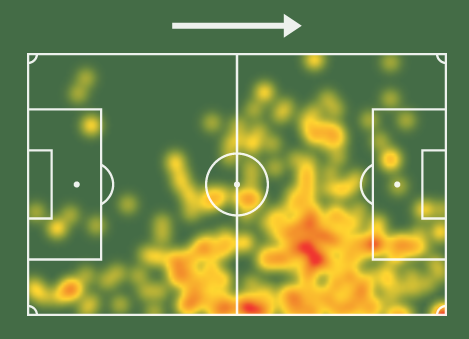
He favors the right side, but as we see from their formations, he can play as a 10. He’s a creative player as his 4.21 shot-creating actions/90, 7.40 take-on attempts/90, and 2.60 successful take-ons/90 show.
For reference, Vargas currently leads Charlotte in SCAs/90 at 5.38 (I’m not including Bender who is at 6.43 because he only has 0.2 90s played), but also only has 2.8 90s versus Bernardeschi’s 5.0. As far as take-ons go, again our leader is a player who has too little time for me to include (Mello at 10.0/90 on only 0.3 90s). Of the players who have played at least 2 games, Karol leads the team at 3.85 take-ons attempted/90. Our leader for successful take-ons (with 2 90s set as the minimum) is Vargas at 2.50/90. Side note: Vargas has been hugely efficient with his take-ons, sporting a 70% success rate.
While Bernardeschi might be the big name, Jonathan Osorio is one of my favorite MLS players. He was a free agent this winter and I held out a ridiculous hope that Charlotte might tempt him away from Canada. In reality, it looks like he was looking for opportunities in Europe, none of which he fancied. Therefore, he returned to Toronto where he’s spent his entire career.
Osorio has made 263 career appearances for Toronto, including 211 starts. He has 43 goals and 33 assists in his career. His best year from a goal production standpoint was 2018 when he had 10 goals and 6 assists. Last year wasn’t too far behind that, though, as he got 9 goals and 4 assists. With the attention players like Insigne (when healthy) and Bernardeschi demand, it really opens things up for him.
For me, 5 games are still too few to take percentiles seriously. Therefore, these are Osorio’s from last year. He was good.
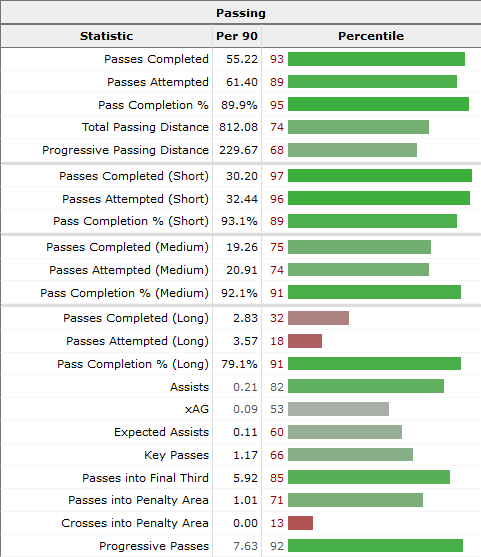
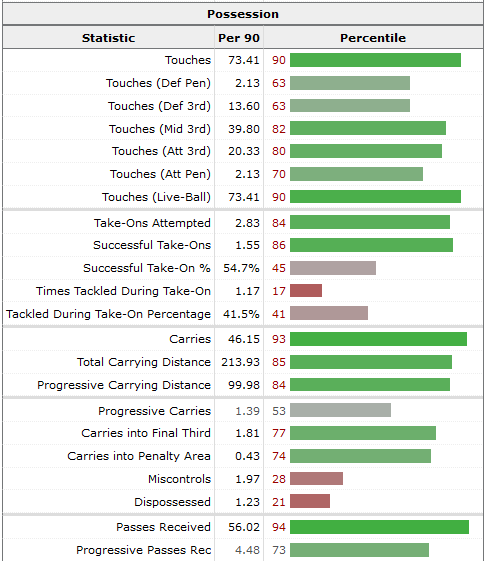
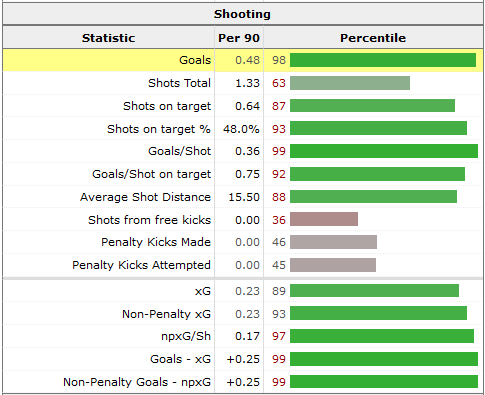
That’s a lot of green! Now, there are some caveats to this.
First, and most obvious, these percentiles compare him to midfielders, not attackers. I would love to see his numbers versus CAMs/wingers.
Secondly, many might consider him a midfielder, not an attacker. Looking at the way he has been deployed by Toronto this year–as a left-sided wide midfielder–is why I have decided to include him here. Further his goal return from last year is more in line with an attacker than a standard CM. As a result, if we were to compare him to more attack-minded midfielders, these numbers might not look as good, but the more important point is they give a clear view of how good a passer, carrier, and shooter he is.
Up top, Deandre Kerr has been their striker for the past 3 games. The 20-year-old has 1 goal so far. Last year he got into 26 games (11 starts) as a 19-year-0ld, scoring 3 times.
Kerr’s positioning seems to have changed from last year. His heatmap (below) shows a right-sided wide player. Indeed, his percentiles are comparing him to midfielders (which is actually rather annoying since it appears he should be compared to wingers/CAMs).
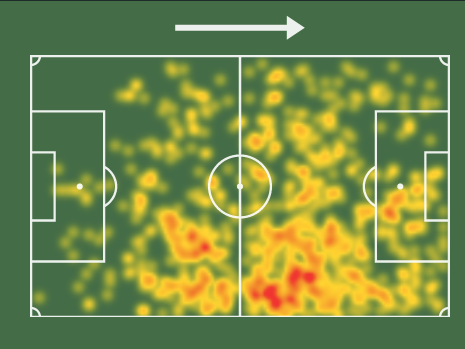
Kerr’s passing is not great. He was at 74.9% last year and is down to 62.1% this year. He’s only attempting 13.2 passes per 90 and only completing 8.18 passes/90, both down from last year. This decrease in the amount of his passing isn’t necessarily surprising due to his change in position.
Adama Diomande was the striker for the first two games. He’s new to Toronto, joining from the amazingly named club, Odd, in the Norwegian Eliteserien. While he’s new to Toronto, Diomande isn’t new to MLS. He spent 3 years (2018-2020) with LAFC, where he made 44 appearances (29 starts), and scored 20 goals with 9 assists. He only made 1 appearance for LAFC in 2020 before moving to the Chinese Super League in 2021. He only made 4 appearances there and moved to Odd in 2022, where he only made 2 appearances. Suffice it to say, the 33-year-old has not been playing much football over the past few years.
Diomande’s best scoring output came all the way back in 2015, when he was 24 and playing for Stabæk in the Norwegian Tippeligaen. He scored 17 goals (2 PKs) in 21 starts that year. He had 12 goals and 4 assists in his first year with LAFC, but aside from those 2 seasons, he’s never had double-digit goal years. While he did miss time due to international duty, it seems to me that he’s a depth piece, and the move to Kerr as striker is where Toronto will be heading this year.
Another older attacker to join Toronto this year is Victor Vázquez (though he rejoins this club, having spent 2 years there previously). Vázquez spent the last 2 years with LA Galaxy, making 54 appearances (36 starts), scoring 5 times, and getting 8 assists. At 36, he’s at the end of his career. He began his career with Barcelona and even made 1 appearance for the club as a 20-year-old back in 2007-2008. He spent most of his career with Club Brugge in the Belgian Pro League, before joining Cruz Azul in Liga MX in 2015-16.
He originally joined Toronto in 2017 as a 30-year-old and spent 2 very productive years there. In 2017 and 2018, he made 52 appearances and 47 starts, scoring 16 times (5 PKs) and getting 14 assists. This includes his first year when he had 10 assists.
Vázquez will pop up all over the pitch but does tend to favor the left side. Historically, he seems to play in similar areas to Osorio, which makes sense when you see that he was the one who took Osorio’s place last match.
Kosi Thompson, Ayo Akinola, and Hugo-Hilaire Mbongue Mbongue make up a triplet of attackers who have featured for Toronto this year but have not started.
Thompson has made 2 appearances for a total of 19 minutes. He did play in 24 games last year, getting 1 goal and 1 assist, as a 19-year-old. He has yet to record a goal or assist this year.
Akinola has made 3 appearances this year, failing to get a goal or assist. He made 26 appearances for Toronto last year, scoring twice. For his career, he has made 67 appearances for Toronto over 6 seasons (he debuted as an 18-year-old for them), scoring 15 goals. He had 9 goals in 15 appearances in 2020 but has never replicated that production again.
Mbongue Mbongue is yet another young attacker at 18. He made 1 appearance for Toronto last year but has already made 3 this year. It’s only been a total of 58 minutes, but Toronto clearly sees potential in him.
Alonso Coello is yet another young attacker (this time a CAM) for Toronto. He’s not even listed on their official roster; only on TFC II’s roster. With that said, he did make his MLS debut last week as their 10. With TFC II last year, he made 24 starts, had 1 goal, and 1 assist. I know little else about him.
The final piece to the attack is Brandon Servania. The just-turned-24-year-old is in his first season with Toronto, having spent the majority of his career with FC Dallas. He had a short loan spell at St. Pölten in the Austrian Bundesliga in 2020-21. He made 10 appearances (7 starts) for the Austrian club but failed to record a goal or assist.
With Dallas, Servania debuted at 19 and would go on to make 67 appearances (43 starts) for the club. He scored 2 goals and had an assist his first year, then went 2 full seasons without getting on the scoresheet. Last year he made 23 appearances (15 starts), scoring twice and getting 3 assists. He’s made 5 appearances with 4 starts so far this year.
Servania’s position is a bit nebulous. He’s started as part of Toronto’s double pivot, as a 10, and as a wide right-sided midfielder over the past 3 games. With Dallas last year, it was a bit more defined.
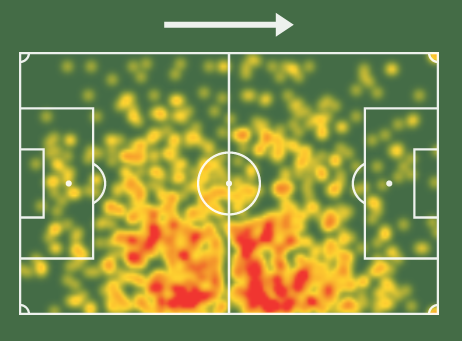
To me, it seems like Servania is primarily a right-sided midfielder, but obviously, he has some positional flexibility which is never a bad thing.
Midfield
The midfield is comprised of that double pivot for TFC and it’s really just two players: Michael Bradley and Mark-Anthony Kaye. Kaye came over midyear from Colorado to help reinforce their midfield, while Bradley enters his 10th season in Toronto. At 35, you have to think the end is near for Bradley, but he keeps churning away. Last year he made 34 starts, scored 3 goals, and got 3 assists.
Kaye, meanwhile, has bounced around a bit over the past couple of years. He spent 4 seasons with LAFC, making 77 appearances, before moving to Colorado in the middle of 2021. He would only spend a year there (parts of 2 seasons), before joining Toronto. Wherever he’s gone in MLS, he’s been a starter. He made 71 starts (77 appearances) for LAFC, 29 for Colorado (32 appearances), and has made 11 already for Toronto (12 appearances).
He’s off to a tremendous goalscoring pace to begin this year, having scored twice already. His previous career high in MLS was 4 goals (and 8 assists!) back in 2019 for LAFC. Perhaps this pace is sustainable, but more than likely it’s not. He consistently chips in goals, but he’s not a scoring threat, per se.
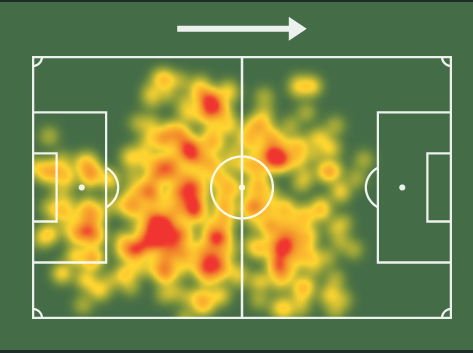
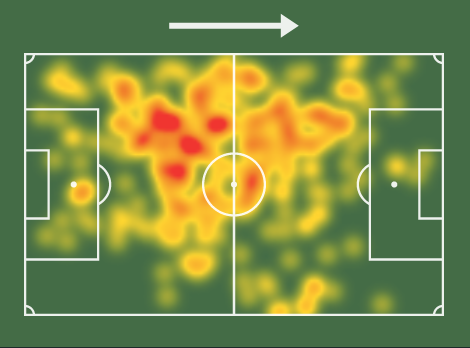
Bradley is a stereotypical CDM now, while Kaye plays a similar role, though he stays on the left much more than Bradley. Bradley is still a pretty good passer, while Kaye is more of a recycler of the ball. In this team, their primary responsibility is obviously to get the ball and keep it so that players like Osorio, Bernardeschi, and Insigne can do damage.
Elsewhere on the roster, there are midfielders Markus Cimermancic, Themi Antonoglou, and Jordan Perruzza. None have made an appearance so far this year.
With the international break over, chances are we are going to see Bradley and Kaye as the midfield partnership (although they could go with someone other than Kaye if he needs some rest).
Defense
If there was one major issue for Toronto last year, it was defense and goalkeeping. Toronto scored 49 goals last year, good for 6th in the East. The problem was they allowed 66 goals, 2nd worst in the East. While not a defender, Kaye was one part of trying to fix that issue. The other was going out and getting almost an entirely new backline (and goalkeeper).
At center back, Toronto brought in MLS veteran Matt Hedges, who had spent his entire 11-year career in Dallas, making over 300 appearances and starts for that club. They also brought in Sigurd Rosted from the Danish Superliga to pair with Hedges. He joined from Brøndby, where he made 84 appearances (69 starts) over 4 seasons. Finally, they brought in left-back Raoul Petretta from Kasimpasa in the Turkish Super Lig. Petretta only spent 1 season in Turkey, making 9 appearances. He spent the previous 6 seasons with Basel in the Swiss Super League, making 109 appearances (99 starts) for that club. These 3 players are aged 32 (Hedges), 28 (Rosted), and 26 (Petretta) and bring a ton of high-level experience to this club and backline.
Hedges is a good reader of the game, as he was in the 76th percentile for blocks, 89th percentile for shots blocked, and 91st percentile for clearances last year. Rosted’s percentiles are versus the “Next 8 Competitions” (i.e., MLS, Brazilian Série A, Dutch Eredivisie, English Championship, Mexican Liga MX, Portugues Primeira Liga, Copa Libertadores, and UEFA Europa Conference League) and, defensively, they are good. He’s in the 89th percentile for tackles, 95th percentile for dribblers tackled, 96th percentile for passes blocks, and 91st percentile for interceptions. The upgrade at this position (CB) has been swift and real.
The only holdover from last year in this backline is Richie Laryea. Laryea has been with Toronto since 2019, making 81 total appearances for the club. He did spend part of 2021-22 on loan at Nottingham Forest (then in the English Championship) but only made 5 appearances and 1 start for Forest. He made 10 starts last year for Toronto, getting 3 assists.
Layrea is a good passer. He’s in the 99th percentile for pass completion % (overall), as well as the 99th percentile for pass completion percentage at short, medium, and long-distance passing. N0w, it should be noted that he was only in the 20th percentile for medium passes attempted and only the 5th percentile for long passes attempted, so it’s not something that he does a ton. He’s in the 79th percentile for progressive passes, as well as the 88th percentile for key passes.
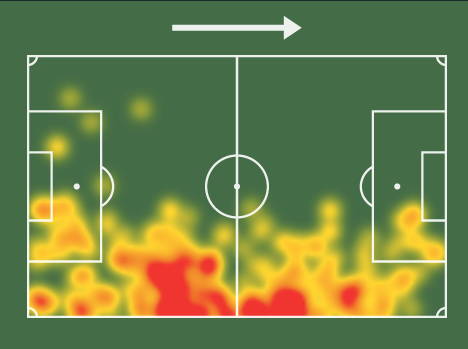
That heatmap shows a more traditional fullback than what Charlotte employs. With Bernardeschi liking to cut in off that right-wing, it makes sense to have Layrea fill that space wide.
Elsewhere in defense, you’ll find Jahkeel Marshall-Ruty. He’s listed as a forward on Toronto’s roster, but FBref has him playing as a right-back in his only appearance this year. He got into 17 games last year (5 starts) and is only 18.
Kobe Franklin is another young defender at 19. He’s appeared in 2 games this year. He only had 1 appearance last year for 14 minutes.
Finally, there is a trio of players who appeared in a number of games last year for Toronto but have yet to do so this year. Shane O’Neill is a center-back who got 21 starts and 26 total appearances last year. Lukas MacNaughton appeared in 25 games last year (20 starts). Jordan Perruzza appeared in 13 games last year (just 1 start). None have gotten off the bench this year.
Goalkeeping
Goalie play was a distinct problem area for Toronto last year. Like the defense, they have basically scrapped their options from last year and started over. Gone are Alex Bono and Quentin Westberg to DC United and Atlanta United, respectively. Bono made 24 starts for them in 2021 and 2022, while Westberg made 10 in each of those same years. Bono had a 1.83 GA90 in 2021 and a 1.75 GA90 in 2022; Westberg had a horrendous 2.20 GA90 in 2021 and a 2.40 GA90 in 2022. To say a change was needed is an understatement. Neither has appeared in a game for their new clubs, which, when seeing those stats, isn’t a surprise.
Greg Ranjitsingh is the only holder, but he hasn’t appeared in an MLS game since 2020 with Minnesota. For his career, he’s only made 5 starts at the MLS level. It should be said that his record in the USL with Louisville City is quite impressive: 78 appearances and a 1.02 goal allowed/90. He’s either never proven himself capable at the MLS level or has never been given a shot.
Tomas Romero is another goalkeeper who has barely played in MLS. He’s younger than Ranjitsingh at only 22. He does have more games at this level, though, they all came back in 2021 when he made 18 starts for LAFC. It didn’t go particularly well, as he had a 1.56 GA90.
Neither Ranjitsingh nor Romero is going to be counted upon this year for Toronto. Instead, Toronto brought in Sean Johnson to shore up their goalkeeping. The USMNT goalkeeper is now in his 14th season in MLS, having played 7 years in Chicago and the last 6 for NYCFC.
Johnson is a good MLS keeper, though I’d say he tends to be in the above-average category, more than the elite. For his career, he has a 1.30 GA90 with a low of 1.07 GA90 in 2021 and a high of 1.68 GA90 way back in 2016 (his final year with Chicago). Over the past 6 years with NYCFC, he’s been solid and ended his time in New York with a 1.19 GA90.
His PSxG+/- backs up that he’s a pretty good keeper. Last year was his worst in some time, as he posted a -0.6 PSxG+/-, but in the previous 4 seasons, he was solidly in the plus. He was at +1.9 in 2018, +3.9 in 2019, +7.0 (!) in 2020, and +2.1 in 2021. So far this year he’s at +0.1.
These numbers are not outrageously good (except for 2020). He’s not Andre Blake or any goalkeeper that NE seems to find, but he’s really solid. He’s an especially solid option when you compare him to Bono’s above GA90 numbers and Bono’s PSxG+/- numbers (career -2.7, including -2.9 in 2021 and only +0.1 in 2022). While every team would prefer to have a Blake or Petrović, those are few and far between. Compared with what Toronto had between the sticks, Johnson is going to seem like a godsend.
Conclusion
Toronto’s start to this season has surprised me. It hasn’t been terrible, but I expected them to make the jump into the upper tier of the league. I really liked the offseason moves they made and, with their superstar attacking Italians, I thought they’d be really dangerous. Insigne’s injury is certainly part of their slow start but probably isn’t the entire reason. As with Charlotte, though, there is still plenty of time for them to turn it around.
Importantly, their defense seems to be getting better. This isn’t surprising considering 3 of the 4 starters are new to the team and each other. They gave up 3 goals in their opening-day loss to DC United, then gave up 1 goal in their next 2 games (both draws against Atlanta United and Columbus). Over the past 2 games, though, they’ve not conceded (a 2-0 win over Inter Miami and a 0-0 draw over San Jose). Considering the level of the opponent, to give up so few goals over the last 4 games is impressive. Charlotte doesn’t know how to score, so this could be a problem.
In attack, it’s a good thing we miss Insigne, but it would’ve been a better thing if we could’ve played them last week when they were missing Insigne, Laryea, Kaye, and Osorio (amongst others). Such is life.
Based on how little news we’ve heard, I don’t expect Westwood to play. This means another week of guessing who mans the midfield, especially with the forced exclusion of Bronico. If I had to guess, we’ll see a midfield of Karol, Nuno, and DJ. Of course, I didn’t see Lindsey starting 2 weeks in a row at RB or Byrne as a CB, so who knows?
Vargas at LW seems a foregone conclusion at this point, though I do wonder if Jóźwiak on the left and Vargas on the right don’t give us the best option now in terms of talent and floor. Mello was electric when he came on and I wouldn’t be opposed to him starting at all, but it just seems unlikely. Further, for a young player learning a new league and coming back from a wasted year due to injury, being a bench player for a bit is probably the prudent choice. I love me some Gaines, but this season has not been good for him so far. A sub role seems appropriate right now with the hope that he’ll get going.
For all the strife around Enzo and his supposed antics, the man has been off to a good start for us. His 2 goals obviously lead the team, but so does his 1.3 xG. Karol isn’t too far behind with 0.8 xG. I’m not sure we could’ve asked for more, especially with how poorly some of our other players have been.
I think his “antics” have been overblown, but more worryingly is that I think he’s being reffed differently already. Against RBNY, he had a foul on Tolkin for which he was given a yellow. I don’t remember other fouls from him before the yellow, so I thought it was not only a soft one, but undeserved. I especially felt that way once a RBNY play did the same thing in the same place on the pitch and didn’t get a yellow.
Some will argue that this difference in reffing might be due to his own behavior. Miss me with that. A referee’s job is to be impartial and call the game fairly. If he/she is so thin-skinned as to let complaining drive his/her decisions, they don’t need to be a ref.
In defense, I do hope that Tuiloma is healthy enough to go. I didn’t think Byrne was that bad outside of the poor trap that led to the goal. To me, he didn’t lose us the game; our inability to do anything with the over 70% possession we had did. At the same time, I do need an experienced professional to handle a backpass better. The bottom line is if he does have to start again at RCB, I’m not overly concerned. It does move Malanda out of the better fit of RCB to LCB, but that kid is so good he can handle it.
Lindsey has not given me a reason to remove him from the lineup. He should continue to start. Meanwhile, Afful has looked really solid in the last 2 games. I’m still skeptical he can keep this up for an extended period of time, but considering the team doesn’t appear to have any intention of getting a new left-back, he may continue to be our best option (so long as we’re inverting that LB). This week will be a real challenge for him, though, as Bernardeschi presents a pace and technical problem.
Finally, George Marks keeps showing out. Marks really has been something else in goal. He’s looked assured on the ball and has had good ideas with his distribution. He hasn’t necessarily executed those ideas well, but when he tries a pass he’s doing so in a way that doesn’t immediately cause danger if it doesn’t come off. When it comes to actually making saves, yeah, he’s doing that too. He’s at 1.00 GA90 in his 2 starts and is at +1.0 PSxG+/- in those starts. That’s really good!
Now, there is the warning that Kahlina also started the year off well with PSxG+/- before ending in the negative, but Marks has clearly played better than Pablo. If this continues, I do think there is a real discussion to be had about whether Kahlina should automatically get the job back.
I wouldn’t say that I’m confident in us going to Toronto and getting a win; last year kind of scarred me. However, if there were ever a time, it might be now. I honestly believe Insigne is that big of a miss for them. Toronto is also near the bottom of the league when it comes to possession at 47.2%. That should play into our desire to keep the ball, though their transition game is more akin to St. Louis and Atlanta than RBNY, I think. I’m going naively optimistic!
Prediction: Toronto 1 – Charlotte 2
Data Notes: All heatmaps come from Sofascore.com. All percentile rankings and percentile charts come from FBref.com. All formation graphics are from MLSsoccer.com. Other websites used for data include transfermarkt.us, Wyscout.com, and MLSsoccer.com.
